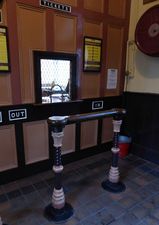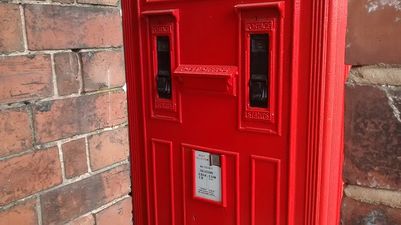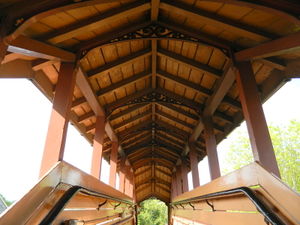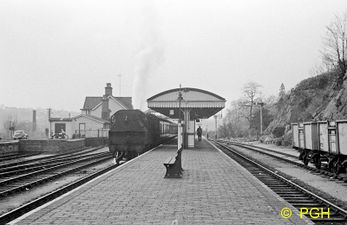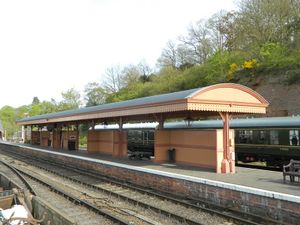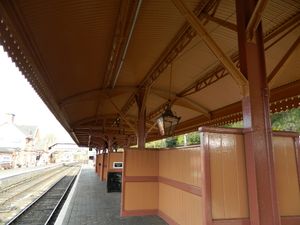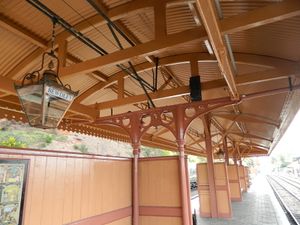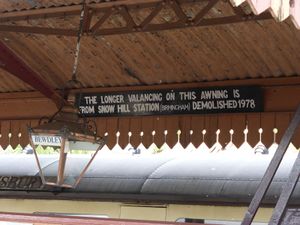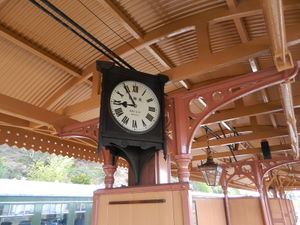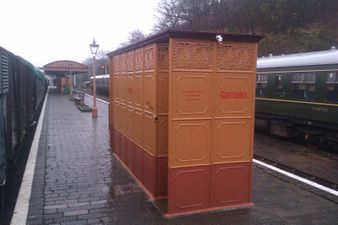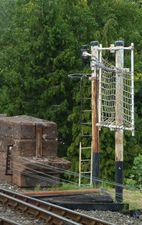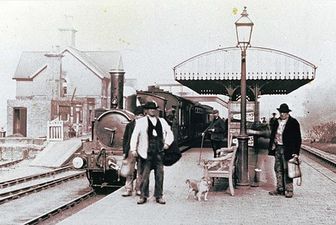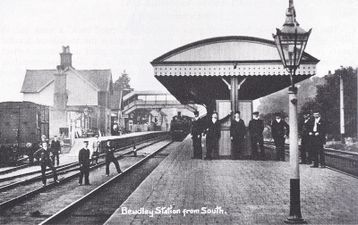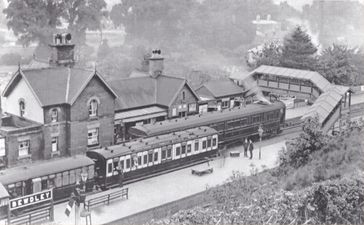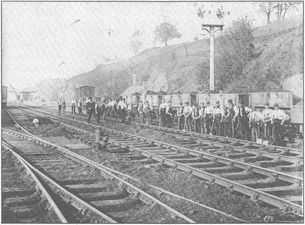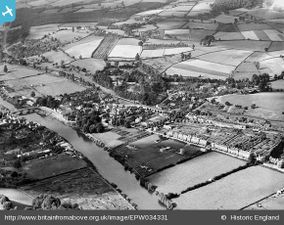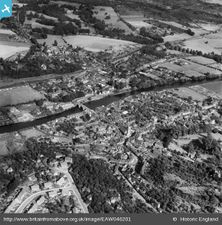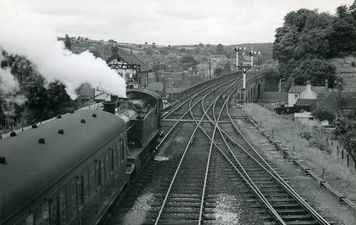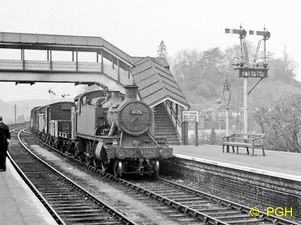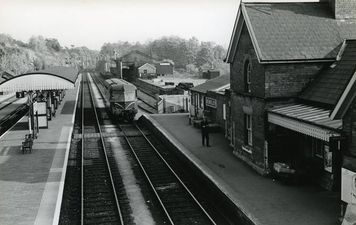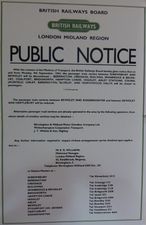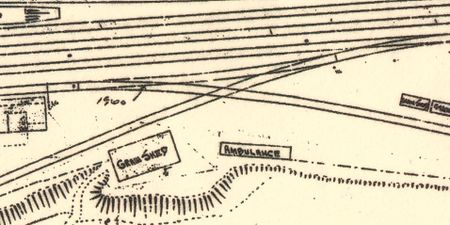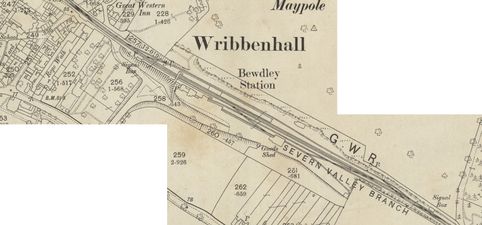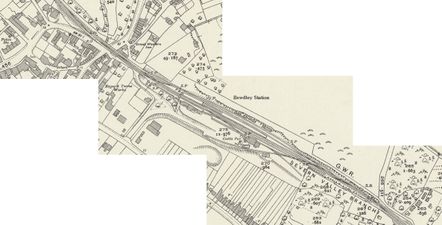Bewdley


Bewdley station in Worcestershire has three platforms and was formerly the junction for both the Wyre Forest and Stourport lines, both of which are now used as sidings.
| Up (towards Kidderminster) | Down (towards Bridgnorth) |
|---|---|
| Kidderminster (3½ miles) | Arley (3¾ miles) via Northwood Halt |
| Towards Hartlebury | Towards Kidderminster | Towards Shrewsbury | Towards Tenbury Wells |
|---|---|---|---|
| Stourport (2½ miles) ) via Burlish Halt (from 1930) |
Kidderminster (3¾ miles) via Rifle Range Halt (1905-1920) and Foley Park Halt (1905-1970) |
Arley (3¾ miles) via Northwood Halt (from 1935) |
Wyre Forest |
The station[edit | edit source]
The station is controlled by two signal boxes, Bewdley South and Bewdley North. The section through platforms 1 and 2 is the only double track section of the present SVR. This is worked under Absolute Block regulations.
Bewdley Down Yard is home to the Carriage and Wagon department which supplements the Carriage Repair Department at Kidderminster and maintains the fleet of goods wagons. A considerable amount of rolling stock is stabled there including rolling stock under restoration. Public access to the yard is available during the annual Open House Weekend (and was formerly available during the Peep Behind the Scenes event).
Bewdley MPD is home to the Class 108 DMU. Other operational locomotives are also stabled at Bewdley, running light engine to Kidderminster at the start and end of each day as required. On certain Gala days a DMU shuttle service is operated between Stourport Triangle, Bewdley and the short remaining length of former Tenbury Branch track immediately north of Bewdley to recreate the feel of a country junction station.
Bewdley Platform 1 is home to the Volunteer Liaison Office.
Legal Charge[edit | edit source]
On 8 August 1988 Severn Valley Railway (Holdings) PLC gave a Legal Charge in favour of the County Council of Hereford & Worcester in respect of "All that land at Bewdley containing six point seven acres or thereabouts together with the buildings erected thereon." The charge was given as security against "All monies due or to become due from the company to the chargee under the terms of agreement dated 10.5.88." As of 2024[update] its status is shown as 'Outstanding'.[1] The Council itself was abolished in 1998 and reverted to the two separate historic counties of Herefordshire and Worcestershire.
Facilities[edit | edit source]
Bewdley has limited public parking, which moved from Pay and Display to ANPR in 2023. Four sales coaches run by support groups are adjacent to the car park.
In March 2018 the buffet adjacent to Platform 1 (but not the more recent toilet block and kitchen) was closed pending demolition of the buffet building, which took place from 16-19 July. BR 4593 Tourist Standard Open was moved to the dock in front of the buffet to be used as seating for staff and the public, with table service provided from the kitchen. In January 2020 a prefabricated timber buffet building was installed on the concrete plinth of the old buffet building, and 4593 was removed.
The main passenger access to island platforms 2 and 3 is via the footbridge, but the only access route for those with restricted mobility is via a barrow crossing at the opposite end of the platform, accessed through the Bewdley Down Yard. A 2021/22 project funded primarily by the Charitable Trust to improve access includes a reinforced concrete path between the gates protecting the rail crossing and the yard gates adjoining the car park, with a branch to the existing disabled toilets; removal of the obtrusive GWR water tower on the island platform; improvements to the crossing itself; and appropriate signage.[2] In October 2022 the SVR announced: "it is hoped that external funding can also support the creation of a disabled toilet facility on the station platform. This will hugely improve facilities for our less-abled visitors"[3].
Points of interest[edit | edit source]
Booking hall[edit | edit source]
The booking hall had been ‘modernised’ by BR with tall ticket windows and plywood facing. The plywood was removed in winter 1980-81 to reveal the original GWR panelling. At the same time the smaller windows were reinstated and fitted with brass wired grids acquired from the old Birmingham Snow Hill station. The balustrades in front of the windows also came from Snow Hill[4].
-
Ticket window and balustrade
Phone box[edit | edit source]
The phone box outside the station is a rare example of the K4 type, introduced in 1930. The K4, nicknamed the Vermillion Giant, was a combined telephone and post box. Only 50 were ever produced.[5]
The box is Grade II listed by Historic England and described as "Intact but not on original site".[6] It arrived on the SVR in winter 1981-82 on permanent loan from the Ironbridge Gorge Museum Trust[7] and was originally situated on Platform 1.[8] A planning application proposal to relocate it to a covered location at The Engine House 'to better protect and display this artefact' was approved in November 2023[9].
-
Phone box at Bewdley
-
Rear view of phone box
Footbridge[edit | edit source]
A covered wooden footbridge at the northern end of the station allows access between Platform 1 and Platforms 2&3. It is numbered bridge 10.
-
Bewdley station footbridge
-
Bewdley footbridge interior
Water towers[edit | edit source]
Two water towers at the southern end of Platforms 2&3 and in the MPD area allow watering of locomotives. The tower on the island platform is of GWR origin and was recovered from Stow Heath yard, Bilston in 1969. The tower next to the MPD is of LNWR origin and was retrieved from Hadley, near Wellington, in October 1972.[10] Both columns were installed during the winter of 1973-74.[11] Unlike at Bridgnorth and Kidderminster, the water supply at Bewdley is not specially treated, and so the columns are only used on rare occasions such as galas.
In October 2020 the Charitable Trust announced a project to improve wheelchair access to the island platform via the barrow crossing next to the MPD. The announcement noted that "The SVR also aim to remove the water tower at the base of the platform ramp as it is causing an obstruction and puddles on the access route. This water tower is not an original feature, but was a later addition, installed during the preservation era, that is no longer essential to operations. This will be relocated to Highley Station."[12]
-
Water towers at Bewdley station
-
Water towers as viewed from the platform
Island platform canopy[edit | edit source]
Platforms 2 and 3 share a canopy, built in 1878, giving passengers protection from the weather. The canopy, featuring timber frames on cast iron pillars was extended around 1900 with the new section supported on steel frames.
-
Bewdley station from the footbridge, showing the island canopy
-
An up train in platform 2 in April 1962 (PG Hindley)
-
Bewdley island platform canopy shortly after completion of refurbishment in April 2016
-
Underside view of the canopy showing the two different methods of construction
-
Underside view of the canopy showing the two different methods of construction
-
The canopy was refurbished using materials from the old Snow Hill station.
Platform clock[edit | edit source]
The double-faced clock under the island platform canopy was built for the GWR by Kays of Worcester in the late 19th or early 20th century. It was used at nearby Stourbridge Junction until 1977 when, no longer required by BR, it was acquired by staff from Arley station. It worked until 1998, but then underwent a year-long overhaul, being re-commissioned on 10 April 1999[13].
-
Bewdley station clock
Urinal[edit | edit source]
An open roofed cast iron gentlemen's urinal is located on Platforms 2 and 3 on the site of the original urinal which was built in 1896 but demolished during the BR era. The replacement was relocated from Melrose in Scotland by SVR volunteers and formally opened in September 1977.[14] See 'Links' below for two copyrighted images of the urinal at Melrose.
-
Bewdley gents urinal
-
Bewdley gents urinal detail
Portable water tank[edit | edit source]
A portable water tank with hand powered pump was used for the refilling of carriage water tanks.
-
Portable water tank
Token catcher[edit | edit source]
The token catcher opposite Bewdley North signal box was originally located opposite Bewdley South signal box, where it could be used by locomotives on the former Stourport Branch. It was moved to its present location during the 1974-75 close season.[15] It is not currently in use, tokens instead being exchanged by hand.
-
Token catcher opposite Bewdley North signal box
Bewdley history before preservation[edit | edit source]

- 1862 Bewdley has a population of 2900[16] (Population; 10869 in 2001)[17]
- 1862: When the Severn Valley Line opened, Bewdley was a crossing point and was deemed a principal station, being provided with a goods shed and goods yard. Construction of the Tenbury and Bewdley Railway and the Kidderminster Loop Line had already been authorised, and the station was always planned to be a junction.
- 1864: The Tenbury and Bewdley Railway opened on 13 August. Around that time turntable was moved from Bewdley and re-erected in the goods yard at Tenbury
- 1877: In preparation for the delayed opening of the Kidderminster Loop, authorisation was given to enlarge the island platform and provide a shelter and footbridge. New Bewdley North and Bewdley South signal boxes were also built.
- 1878: The Kidderminster Loop opened on 1 June.
- 1900: Authorisation was given for additional siding space including the Rock Siding at the back of Platform 3 and the siding along the far side of the yard.
- 1911: Great Western Magazine included a photograph of Bewdley Ambulance Class taken by TJ Ricketts of Bewdley. The Mayor had presented awards - supervised by HK Woodward, Divisional Engineer.[18] A 1935 GWR plan of Bewdley shows an "Ambulance" in the Down Yard. This was a grounded M&SWJR coach body used as a First Aid training centre.
- 1922: GWR staff records show the station had a staff of 19.
- 1924: The island platform was extended from 400 to 515 feet to serve excursion traffic. Subsidence, landslip and sand washed onto the line between Arley and Kidderminster and Hartlebury - including Bewdley - affected services from 31 May to 3 June.[19]
- 1927: A new 20 ton cart weighbridge for motor vehicles was provided.[20]
- 1932: A small warehouse was added.[21]
- 1939: It was announced that "A new warehouse is being provided at Bewdley", probably referring to the Provender Shed at the far end of the yard.[22]
- 1962: Passenger services to Tenbury ceased on 31 July[23] (services beyond Tenbury to Woofferton had ended a year earlier).
- 1963: Passenger services towards Shrewsbury ceased on 9 September, with through freight services ending at the end of November. The Public Notice announcing closure of the line can be seen behind the ‘Platform 1’ sign in the photograph to the right (a copy of the closure notice is on display in The Engine House).
- 1964: Goods services ended on the Tenbury Branch and the line was closed.
- 1965: The goods yard closed on 1 February.
- 1969: All goods traffic north of Bewdley ceased with the closure of Alveley Colliery. This enabled the SVR Society to rent the former goods-shed and yard (even though they had not yet opened the first section of the railway between Bridgnorth and Hampton Loade by that time). This space was used for restoration of locomotives and rolling stock, 4566 and 1501 being among the earliest residents.
- 1970: Passenger services to Kidderminster and Hartlebury ended on 5 January, ending the pre-preservation use of Bewdley Station.
There was reference to a 'fruit pulping depot' at Bewdley under the Ministry of Food immediately after the Great War.[24]
-
Bewdley Station in 1898
-
Bewdley Station circa 1910
-
A GWR Steam Railmotor at Bewdley circa 1908-1911
-
Permanent Way gang at Bewdley
-
Aerial view of Bewdley in 1930
-
Aerial view of Bewdley in 1952
-
A train waits to depart Northbound from Platform 1 in October 1959 (Sellick Collection)
-
An up goods passes Bewdley in April 1962 (PG Hindley)
-
Closure notice
-
Plan showing ambulance in Down Yard
| Name | Born | From | To | Comments |
|---|---|---|---|---|
| Thomas Appleton | 26 April 1826 Newton-Le-Willows, Lancashire | August 1863 | 31 January 1897 | Joined West Midland Railway October 1854. Retired 1897. Died 17 April 1906, Worcester |
| William John Curtis | 16 July 1859 Salisbury, Wiltshire | February 1897 | August 1898 | |
| George Smith | 14 January 1867 Shipton Oxfordshire | September 1898 | 1 December 1909 | Started work 6 November 1882. Later Station Master at Bridgnorth |
| Frederick William Augustus Hallett | 12 August 1868 Batheaston, Somerset | 1 December 1910 | 23 July 1914 | Started work 9 January 1882. Died in 1914 aged 46 in a nursing home at Proud Cross, Kidderminster while awaiting an operation.[25] |
| Ernest James Neate Carter | 21 September 1879 Slough, Buckinghamshire | September 1914 | December 1927 | |
| George William Lane | 31 May 1872 Hartlebury, Worcestershire | After 1927 | Previously station master at Hartlebury | |
| William John Barton Banbury | 11 June 1880 Teignmouth, Devon | 1930s | By February 1937 | Previously station master at Cleobury Mortimer, by 1937 station master at Stourport |
| Alfred Walter Cooke | 15 September 1886 Witney, Oxfordshire | April 1937 | Previously employed at Bridgnorth, Much Wenlock and Eardington and station master at Cleobury Mortimer. |
| Passenger Traffic | Freight Traffic | |||||
|---|---|---|---|---|---|---|
| Year | Tickets issued | Parcels despatched | Revenue (£) | Tons received & despatched | Revenue (£) | Total revenue (£) |
| 1903 | 63,131 | 15,577 | 4,296 | 16,588 | 5,076 | 9,372 |
| 1913 | 82,475 | 19,845 | 4,702 | 17,020 | 4,074 | 8,776 |
| 1923 | 92,463 | 16,783 | 7,584 | 20,171 | 7,553 | 15,137 |
| 1929 | 92,479 | 17,812 | 6,202 | 20,201 | 8,875 | 15,077 |
| 1930 | 88,763 | 14,840 | 5,251 | 19,323 | 7,812 | 13,063 |
| 1931 | 69,627 | 14,706 | 4,922 | 20,599 | 9,227 | 14,149 |
| 1932 | 56,206 | 13,689 | 4,042 | 16,907 | 7,180 | 11,222 |
| 1933 | 56,012 | 15,578 | 4,007 | 15,158 | 6,802 | 10,809 |
| 1934 | 55,051 | 15,834 | 4,061 | 14,797 | 6,679 | 10,740 |
| 1935 | 61,135 | 16,093 | 3,988 | 13,668 | 5,920 | 9,908 |
| 1936 | 63,262 | 16,300 | 3,896 | 14,457 | 6,931 | 10,827 |
| 1937 | 66,925 | 16,001 | 4,164 | 13,357 | 5,627 | 9,701 |
| 1938 | 60,251 | 14,120 | 3,748 | 10,874 | 3,833 | 7,581 |
| 1942 | 93,092 | X | 7,325 | 17,227 | X | X |
| 1947 | 72,637 | 12,251 | 6,479 | 13,376 | X | X |
| 1952 | 64,647 | 9,138 | 5,328 | 28,528 | X | X |
X: Data not recorded
Historic maps of Bewdley Station[edit | edit source]
- GWR plan of Bewdley station with the original lines in blue and the Rock Siding and alterations to the Down Yard as later amendments in red
- 1884 map showing scissors crossovers at both ends of the station and the short platform canopy
- 1903 map showing facing and trailing crossovers, the Rock siding and an additional siding in the goods yard
- 1927 map showing the longer platform and canopy and changes to the southern access to the Back Road and Rock Siding
- 1938 map showing little had changed since 1927
- 1964 map showing showing changes to the southern access to the Back Road and the goods yard
- 1905 GWR schematic plan of Bewdley giving siding capacities and other details.
-
1884
-
1903
-
1927
-
1938
-
1964
-
1905
See also[edit | edit source]
Bewdley Down Yard
List of stations
List of shops
Tenbury & Bewdley Railway
References[edit | edit source]
- ↑ Companies House (Retrieved 29 February 2022)
- ↑ Branch Lines, October 2021
- ↑ Branch Lines October 2022
- ↑ SVR News 59
- ↑ RedPhoneBox.info
- ↑ Historic England listing entry for the phone box
- ↑ SVR News 62
- ↑ SVR News 66
- ↑ Wyre Forest District Council planning application 23/0418/LBC (Retrieved 14 March 2024)
- ↑ SVR News 29
- ↑ SVR News 31
- ↑ Charitable Trust 2020 News page
- ↑ SVR News 130
- ↑ SVR News 45, pp. 26-28
- ↑ SVR News 36
- ↑ Handbook to the Severn Valley Railway, J. Randall, 1863
- ↑ 2001 census
- ↑ Great Western Magazine, January 1911
- ↑ Great Western Railway Magazine, July 1924
- ↑ Great Western Railway Magazine, June 1927
- ↑ Great Western Magazine, January 1933
- ↑ Great Western Railway Magazine, February 1929
- ↑ Beddoes and Smith ((1995) p. 193.
- ↑ Great Western Magazine, May 1937
- ↑ Great Western Magazine, September 1914
Early Station Masters data taken from census and GWR staff records by Reg Instone, who is involved with the Signalling Records Society, the LNWR Society and the GWR Study Group. Additional information from Chris Haynes.
Links[edit | edit source]
Bewdley Station web site
Volunteer Liaison Office web site
Image of "Melrose, Railway Station, urinal View from W" 8/4/1974
Image of "Interior of cast-iron urinal at Melrose Railway Station, Melrose, Roxburghshire", n/d
| ||||||||||||||||||||
